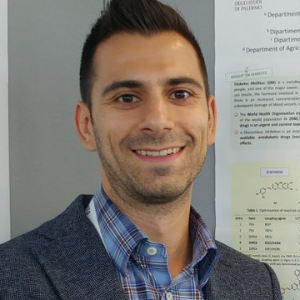Title : Natural and synthetic polyphenols as carbohydrates hydrolyzing enzymes inhibitors
Abstract:
Carbohydrates are among the main nutritious components of human diet. Normally, the blood sugar level after meal highly responses to the digestion of carbohydrates, mainly starch. They are initially hydrolysed by salivary and pancreatic α-amylase to reducing into oligosaccharides. Then, the reducing sugars are digested by pancreatic α-glucosidase to glucose that enters blood circulation. Therefore, retarding the starch digestion by inhibiting the activity of essential hydrolysing enzymes, namely α-amylase and α-glucosidase, is beneficial to health as it alleviates the stimulation to pancreatic islet B cells. Furthermore, controlling postprandial blood sugar level is useful in regulating some glycometabolism-related diseases, for example type 2 diabetes. Type 2 diabetes develops in adulthood and is mainly related to incorrect lifestyles (sedentary life), industrially sourced food and some chronic degenerative diseases. Furthermore, in chronic conditions, hyperglycaemia causes the onset of other diseases (retinopathy, nephropathy, heart attacks, etc.) and an increase in the production of reactive radical species, with consequent oxidative damage to the involved tissues.
In 2019, diabetes has been included in the top 10 global causes of death, thus, there is an urgent need in the search of new and effective antidiabetic drugs, besides considering certain side effects showed by commercial antidiabetic drugs. The inhibition of the activity of α-amylase and α-glucosidase is an established protocol in the search for potential antidiabetic agents with hypoglycaemic activity. Given the slight or absent side effects on naturally occurring compounds, the search is pointed to the discovering of new hypoglycaemic agents from natural sources.
In the last decade, an increasing number of papers has been dedicated to the hypoglycemic effect of natural extracts and their main constituents. Among natural products, some polyphenols occurring in edible plants showed promising α-glucosidase and/or α-amylase inhibitory activity. Moreover, the well-known antioxidant properties of polyphenols represent a further advantage in the search for potential dual-action antidiabetic agents, with both hypoglycemic and antioxidant activity.
Tannins, flavonoids and phenolic acids are natural products belonging all to the polyphenol family and are considered promising lead compounds in the search for new anti-diabetic drugs. Some authors have discussed their structure-activity relationship, however the exact inhibition mechanisms of α-glucosidase α-amylase by polyphenols are still unclear.
In this scenario, we have focused our research activity on the study of hydrolysable tannins, such as C-glucosidic ellagitannins and galloylated glucoses; phenolic acids, such as rosmarinic and chlorogenic acids; and bisphenol neolignans, such as magnolol, as α-glucosidase and α-amylase inhibitors. Consequently, several analogues and derivatives of the above-cited natural polyphenols have been synthesized and evaluated as hypoglycemic agents.
UV and fluorescence spectroscopy have been employed to deeply analyze the inhibition mechanism of the most promising hypoglycemic agents as well as binding mode analyses of these compounds using molecular docking simulations have been performed.
Audience take-away:
- Nature provides a huge library of compounds with known and yet undiscovered biological properties.
- Most of the natural compounds we usually take with diet carry out beneficial health effects (nutraceuticals) and preventive action towards several diseases every day.
- Medicinal chemistry and organic chemistry are useful tools to study and understand the mechanisms of action of natural compounds as well as to obtain new molecules with enhanced biological activity.
- Simple and generally available spectroscopic techniques (UV, fluorescence, NMR) allows the study of the mechanisms of inhibition and or interaction of small molecules with biological targets.




